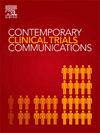Statistical analysis plan for the 24-week randomised trial of hypoglycaemia prevention, awareness of symptoms, and treatment: HypoPAST
IF 1.4
Q4 MEDICINE, RESEARCH & EXPERIMENTAL
引用次数: 0
Abstract
Background
The HypoPAST (Hypoglycaemia Prevention, Awareness of Symptoms, and Treatment) randomised controlled trial aims to examine the effectiveness of an online psycho-educational intervention for reducing fear of hypoglycaemia among adults with type 1 diabetes. This statistical analysis plan provides the framework to assess the primary, secondary, and safety outcomes of the trial. The plan was written prior to database lock and in accordance with the SPIRIT guidelines.
Methods
HypoPAST is a 24-week, two-arm, parallel-group, hybrid type 1 randomised controlled trial. The primary outcome is the difference in mean Hypoglycaemia Fear Survey II Worry subscale scores at 24 weeks between intervention and control arms. Secondary outcomes include between-arm differences in psychological, clinical and behavioural measures at mid- and end-trial. Primary and secondary outcomes will be analysed using mixed-effects models under the intention-to-treat principle. A sensitivity analysis will examine assumptions regarding missing data, and a per-protocol analysis will estimate the intervention effect among participants who engage with HypoPAST. Table shells for all prespecified analyses are provided to support transparent reporting.
Conclusion
Consistent with best practice, all analyses described were prespecified prior to completion of trial data collection. The analysis methods were developed by statisticians, with input from trial investigators. This analysis plan provides a rigorous framework for the analysis of the HypoPAST trial data, ensuring the results will be robust and reproducible.
Trial registration
The trial is registered on the Australian and New Zealand Clinical Trials Registry: ACTRN12623000894695 (August 21, 2023).
低血糖预防、症状意识和治疗的24周随机试验的统计分析计划:HypoPAST
背景:HypoPAST(低血糖预防、症状意识和治疗)随机对照试验旨在研究在线心理教育干预在减少成人1型糖尿病患者对低血糖的恐惧方面的有效性。该统计分析计划提供了评估试验主要、次要和安全性结果的框架。该计划是在数据库锁定之前根据SPIRIT指南编写的。方法:shypopast是一项为期24周、双臂、平行组、混合型1型随机对照试验。主要结局是干预组和对照组在24周时低血糖恐惧调查II焦虑分量表平均得分的差异。次要结局包括试验中期和末期心理、临床和行为测量的组间差异。主要和次要结果将在意向治疗原则下使用混合效应模型进行分析。敏感性分析将检查关于缺失数据的假设,每个协议分析将估计参与HypoPAST的参与者的干预效果。为所有预先指定的分析提供了表壳,以支持透明的报告。结论与最佳实践一致,所描述的所有分析都是在完成试验数据收集之前预先指定的。分析方法是由统计学家根据试验调查人员的意见制定的。该分析计划为HypoPAST试验数据的分析提供了严格的框架,确保结果稳健且可重复。试验注册该试验在澳大利亚和新西兰临床试验注册中心注册:ACTRN12623000894695(2023年8月21日)。
本文章由计算机程序翻译,如有差异,请以英文原文为准。
求助全文
约1分钟内获得全文
求助全文
来源期刊

Contemporary Clinical Trials Communications
Pharmacology, Toxicology and Pharmaceutics-Pharmacology
CiteScore
2.70
自引率
6.70%
发文量
146
审稿时长
20 weeks
期刊介绍:
Contemporary Clinical Trials Communications is an international peer reviewed open access journal that publishes articles pertaining to all aspects of clinical trials, including, but not limited to, design, conduct, analysis, regulation and ethics. Manuscripts submitted should appeal to a readership drawn from a wide range of disciplines including medicine, life science, pharmaceutical science, biostatistics, epidemiology, computer science, management science, behavioral science, and bioethics. Contemporary Clinical Trials Communications is unique in that it is outside the confines of disease specifications, and it strives to increase the transparency of medical research and reduce publication bias by publishing scientifically valid original research findings irrespective of their perceived importance, significance or impact. Both randomized and non-randomized trials are within the scope of the Journal. Some common topics include trial design rationale and methods, operational methodologies and challenges, and positive and negative trial results. In addition to original research, the Journal also welcomes other types of communications including, but are not limited to, methodology reviews, perspectives and discussions. Through timely dissemination of advances in clinical trials, the goal of Contemporary Clinical Trials Communications is to serve as a platform to enhance the communication and collaboration within the global clinical trials community that ultimately advances this field of research for the benefit of patients.
 求助内容:
求助内容: 应助结果提醒方式:
应助结果提醒方式:


